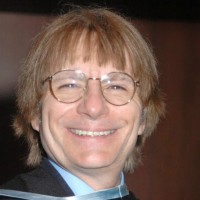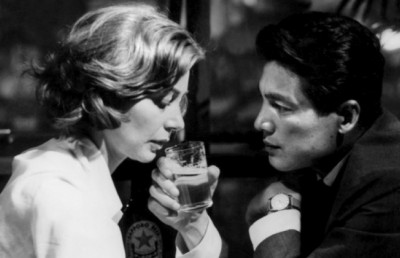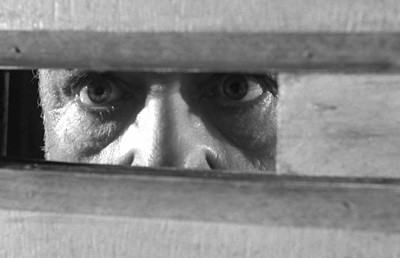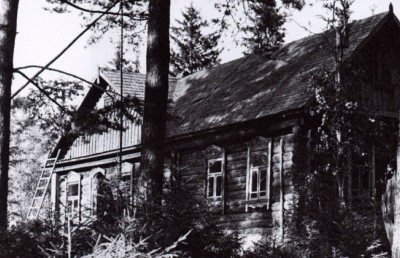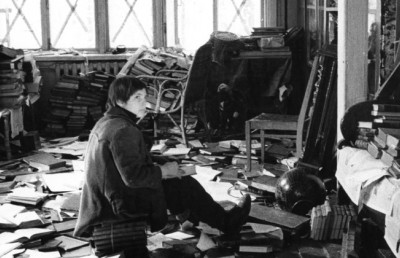Toward a Synthesis of Cinema -A Theory of the Long Take Moving Camera, Part 2
Bazinian Theory
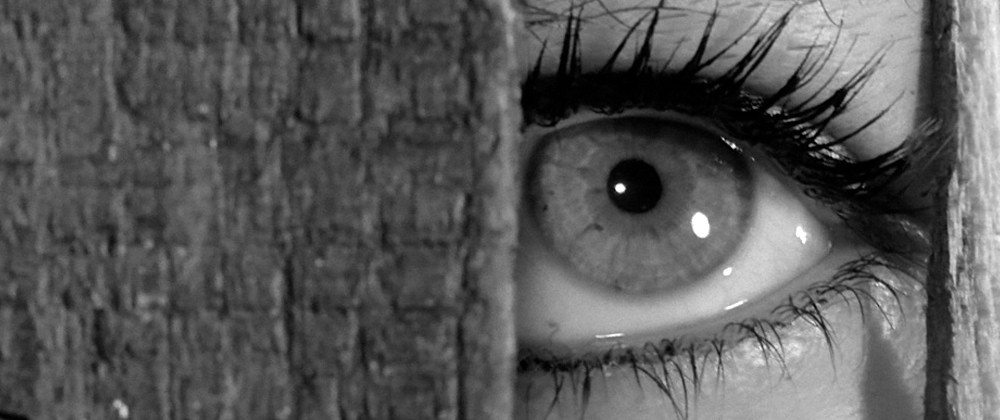
The stage is now set for the second part of this essay: a discussion of spatial-temporal relations in The Trial, that is, an examination of Welles’ long take cutting style for the purpose of pointing the way toward a possible approach to the development of a theory of film. Joseph K. is characterized as being in conflict with other characters which brings about an evolution in his attitude, an affirmation of self, and a tension between himself and the exterior world. Initially, it is the “Voice” of the enunciator pronouncing the words from the Parable of the Law which evokes the miserable destiny of a man (Joseph K.), a human being with apparently no history, facing the indiscriminate accusations and suppressive forces of the law; and thus, a mental picture is conjured up from the legend about the impossibility of crossing to the other side of the door that leads to the truth, immediately establishing an ironic distanciation with regard to K. and the prediction of his inevitable downfall. But it is Welles’ brilliant use of spatial-temporal relations via his long take cutting style that sets the filmic overtones to this story (taking the “Voice” as the fundamental harmonic of tonality). It is through the Image and particularly the representation of space, that puts Joseph K. in danger of losing his individuality, including his life; and also, it is this space that puts him in conflict with the voice. The decorative mise-en-scènes are immense and out-of-scale in proportion to the protagonist’s stature; moreover, they seem deliberately created to lose him in their vast expanses. Welles’ utilization of the wide angle lens in the low-angle shot has the effect of making Joseph K. larger than he really is, and at the same time, it shows the extensive spread of the high ceilings which dwarf the true size of this pathetic individual. Amazingly, this effect of “dwarfing” the character works both ways; because in the opening sequence of the film, specifically scene two (i.e. THE ARREST: a duration equal to 7’08”), the inverse situation is achieved through a brilliant mise-en-scène cinematography. The arrest at his apartment house shows K., a tall man, as if he is already in prison, ensnared in a space overly narrow and crushed by a ceiling exaggeratedly low. The effect is the same because the filmic environment is there to compress the character into submission (i.e. to make him “conform” [ref. to Bernardo Bertolucci’s The Conformist ]).
Another example of the “dwarfing effect” occurs when K. leaves the tribunal, after a verbal retort from the Presidential Chairman, where he finds himself in the position of having to close a door that has become humongous, not really being able to reach the door knob located above his head. As mentioned before, K. finds himself excessively small as he exits the tribunal, especially as he confronts the immensity of the door which, in the parable, symbolically signifies the impossibility of opening the portal to real justice; and ironically for K., it is he who musters the grandeur and strength to “close” this door that forbids him access to truth and justice. This Image epitomizes the thematic meaning of this entire film through the stylistic visual delivery of Welles’ cinematic deftness. It shows more than the stalemate that is implied in the ending of the film; because here at the portal of justice, it shows a “checkmate” that can only be attributable to the character’s own responsibility toward himself. In a sense, the viewer may suppose that it is the presence of objective reality that opposes the protagonist’s thought processes. It is important to realize that the intervention of the narrator in cinema is not only accomplished through the power of the Voice which addresses itself to the audience. In advanced applications of film theory (as is the case with Welles), the Voice can become synaesthetically sensitized at the moment in which the Image detaches itself from the mimetic illusion, through the usage of de-framing or distortion caused by the unusual movement of the camera or cutting style. The applications of such cinematic techniques are akin to “touch-ups” performed in painting which allow for accentuation of the work of art.
The above explanations describe the affluent utilization of visual counterpoint by Welles who mixes stylized cutting with long take moving camera maneuvers. Examples of such “image-counterpoint” abound in The Trial. For instance, the first appearance of Hastler into the story introduces a succession of alternating shots/counter-shots which put into opposition Joseph K. with the lawyer who stands on the dais (i.e. a raised platform) of his bed. Recalling Welles’ finesse of shifting perspectives in Citizen Kane (1941), a return of such an effective “trompe l’oeil” technique, utilizing alternating high- and low-angle shots where K. is framed minuscule in one shot while Hastler becomes gigantic in the following counter-shot, is often at play in The Trial; as is the continual application of depth of field, long take and moving camera techniques. According to Professor Donato Totaro’s scene breakdown of The Trial (see at end of paper), the average scene length is 4’ 18”, with nearly half the scenes over 5 minutes in duration. 1 Several of these scenes are structured around shots that continue for a long duration. This is interesting because “duration” (a term that is linked to Deleuze’s image-ontology and his concept of becoming in film) plays a major part in the “montreur de marionnettes” style as demonstrated in The Trial.
As mentioned earlier, the intrusion of the enunciator in the initial prologue with its diegetic link to the character of Hastler creates a film that is circumlocutory in nature, continuously swinging back on itself, as demonstrated by its excessive textural richness, baroque decorative profusion and talkative dialogue. The ambiguous narrator is the “marionnettiste” who brings the spectator into his world, the director’s world, a world that is external to the diegetic world of the story (as opposed to the mimetic world of traditional cinematic). It also has the function to “blink” at the spectator in a similar manner to the cowboy who discharges his gun directly at the audience in Edwin Porter’s last (or first) shot of The Great Train Robbery (1903). Orson Welles is one of many who deliberately attempts to show the existence of the invisible region or forbidden zone of classical cinema, a place where the camera and spectator reside. Welles brings to light the conspiracy of the traditional cinema (ref. the concept of the “fourth wall”) while in fact, there is no such thing as an invisibly omnipresent camera. He shows us just this fact when the enunciator addresses the spectator via the Parable of the Law or when Joseph K., making an exclamatory allusion about the parable to a public while apparently acknowledging its presence, says (paraphrasing his words): “All the world has heard it.” All such instances represent a form of heterogeneity of the cinematic space which is obviously absent in the novel. The story unfolds in time as the camera-spectator eye views it from a point “exterior” to it, and not as an invisible camera that moves with all possible degrees of freedom “inside” the story. The negative fallout to Welles’ systematics (concerning the presence of an enunciator) is that it can create a distanciation between the diegesis and the spectator which partially attenuates his suspension of disbelief; whereas the classical cinema is founded on the illusion of a disappearing narrator. Nevertheless, Welles is extremely successful in his “montreur de marionnettes” approach which allows for the presence of an enunciator at an intermediary level inside the film but distinct from the diegetic level; moreover, he is not the first director to do this since a comparable approach is adopted by Bertolt Brecht who introduces deliberate “distanciation” into his plays. Thus, a partial foundation for the development of a future theory of the long take moving camera cutting style is beginning to appear, as it is seen in The Trial where Welles is counterbalancing “distanciation” with “duration.”
Welles attempts to unify diverse aspects of film that are excluded from the classical theories of cinema, doing so by a creative force of will that is unique to his systematics. Welles combines the power of the enunciating Voice with the gradual, undifferentiated detachment of the deep focus long take Image and arrives at creating a form of art-film that is akin to Deleuze’s cinema of becoming, a cinema of great movement duration. Gilles Deleuze explains:
Certain great movements are like a director’s signature, which characterize the whole of a film, or even the whole of an oeuvre, but resonate with the relative movement of a particular signed image, or a particular detail in the image. In an exemplary study of Murnau’s Faust (1926), Eric Rohmer showed how the movements of expansion and contraction were apportioned between people and objects in a ‘pictorial space’, but also expressed genuine ideas in the ‘filmic space’ – Good and Evil, God and Satan. Orson Welles often describes two movements which are formed, one of which is like a horizontal linear flight in a kind of elongated, striated cage, lattice-worked, and the other a circular sweep whose vertical axis performs a high or a low angle shot from a height: these movements are those which had already inspired Kafka’s literary work and we infer that Welles has an affinity with Kafka which goes beyond the film of The Trial, explaining why Welles needed to confront Kafka directly. 2
Scene Analysis
The terms scene and sequence are sometimes used together, with sequence encompassing scene, or collapsed and used interchangeably. For the purposes of this analysis I have decided on the latter option, with scene defined as,
A unified action within the film’s plot that normally takes place in a single location and in a single period of time. The plot it self is made up of a series of connected scenes. Sometimes a single scene can take place in more than one location –for example, when the single action of a chase moves us from place to place. 3
Both the number of scenes (27) and their average length (4’18”) in The Trial seems to fall within the statistical average for a feature length film (15-30 scenes, 2-5 minutes each). Since The Trial frequently employs the long take film, it implies the existence of possible sequence shots imbedded in its narrative structure. With 27 scenes, there are 26 potential inter-sequence cuts which are of great interest since they can help determine the expressive qualities of the long take cutting style which Welles aspires to achieve. Recall that a sequence shot is a form of a long take where the term “sequence” stands for a large block of dramatic unity.
The Trial is a film that involves emotive camera movements that form part of the sequence shot structure which gives it a long take style; moreover, its sequence/scene shots are linked by inter-sequence cuts that come between them to provide instantaneous changes in mood, tempo and tone (as well as dramatic contrast). Recall that within a sequence/scene shot, there can be intra-sequence cuts that must be expressive breaks in the rhythmic denouement of the sequence/scene, reconnecting it on a new basis of modulation. The question to ask in such an investigation is: “Are there any sequences/scenes in The Trial that are made up of only one shot?” Since the first scene (2’ 53”) is the equivalent of the film’s prologue and made up of fixed imagery (i.e. photographic stills), it will be omitted from the investigation. The second scene (7’ 08”) is not quite a sequence shot because of internal intra-sequence cuts. Briefly, the “Arrest of Joseph K.” (scene #2) opens in the following way [ref. Fry, Nicholas, trans. The Trial: A film by Orson Welles., pp. 17 – 22]:
Shot 19: We are inside K’s bedroom. Close-up from above, at first slightly out of focus, of Joseph K sleeping peacefully in his bed. Normally he has another two hours’ sleep left. However, now we hear the off-screen noise of a key turning in a lock. K opens his eyes.
Shot 20: Low angle medium, as from the bed, of a double door opening slightly.
Shot 21: High angle medium close-up of K waking and sitting up. K: “Miss Burstner?” Camera pans left with him as he sits up, to show the door in the background. The silhouette of a Man, seen from below, comes stiffly through the doorway. The Man shuts the door behind him. Inspector A: “You were expecting Miss Burstner?” K is now seen behind, sitting on his bed. The Inspector, facing us in the background, goes to the window. Camera pans slightly left …
Shot #21 goes on for quite a while until it reaches the next shot.
Shot 22: Reverse shot of the doorway from the other side as K opens it. The two policemen stand on either side behind.
Shot 23: Reverse angle medium long shot of Miss Burstner’s room. On the far side three men turn around. They have been looking at some photographs lying on an upended trunk by the bed.
Shot 24: Resume on K, bewildered. K: “You’re from my office?”
Shot 25: Resume on the three men, who greet K with ceremonious bows …This scene (#2) continues like this for a spell until it reaches a crucial turning point, marking its ending and the beginning of the next scene (#3).
Shot 34: Low angle medium close up of K coming out of the door. Assistant Inspector 1: “ … to give me anything .. sir? Mister?” K snatches a shirt from Assistant Inspector 2 who is standing in the passage. Assistant Inspector 1 follows him out and stands by his colleague. Assistant Inspector 2: “We’re … we’re leaving, mister. Assistant Inspector 1: “You’re not going to be one of them trouble makers now, are you?” As he speaks, the camera tracks sideways, panning from a low angle, to follow K as he goes into Mrs. Grubach’s kitchen [IT IS HERE THAT THE INTER-SEQUENCE/SCENE TRANSITION OCCURS]. We see him from the side. Mrs. Grubach is busy at the stove. K: “Mrs. Grubach.” Mrs. Grubach turning around, embarrassed: “Good morning, Mr. K. I’ve got your breakfast ready.” As K goes towards a corner of the kitchen, carrying a shirt, she goes off to the right …
As pointed out by Donato Totaro, something quite remarkable has occurred within this shot. We have witnessed a ‘scene transition’ of a unique order, an atypical equivalent of an inter-sequence/scene cut: an inter-sequence shift rather than cut, (i.e. it functions as a “cut-less” cut preserving the sense of continuity much as a “hidden” cut does). This fact alone makes Welles’ The Trial a potential source for new insights and encourages the development of a paradigmatic platform for long take theories of the future.
To recapitulate, Welles uses intra-sequence/scene and inter-sequence/scene cuts in The Trial that have selected levels of expressive interpretation, sometimes meant to derail the rhythm and at other times to transpose its cinematic elements. Such editing is never invisible but in the case of the transitional inter-scene shift scene of shot #34, the “in-camera” editing is quasi-invisible. With his editing style Welles is deliberate not cutting when the audience wants a cut, prolonging the agony of the drama via the long take camera movement in order to create a sense of claustrophobia and suffocating confinement (e.g. camera shot of the ticking of the clock 06:14 A.M.).
And when the spectator reaches the near-point of viewer exhaustion, Welles cuts with an uncommon “radical virtuosity” (ref. Mark Le Fanu’s article “Metaphysics of the long take”), often from either high- to low- angle or vice versa. With the character of Joseph K. Welles is able to make him appear “guilty,” especially in front of the authorities (and this is all done amazingly with the long take moving camera and selective cuts). Moreover, the whole film plays with the motif of the “door,” including many variations of it, such as doorways functioning as entrances or exits, opening and closing of doors, and most importantly, of the long passageways above and below ground (ref. the succession of shots that move the viewer from Titorelli’s art studio to the Cathedral where Hastler [Welles’ alter ego] is manipulating a slide projector).
In The Trial, both the space and the camera become as one, a single living entity, capable of reacting to situations and especially able to surprise Joseph K., and even the spectator within the vast expanse of its immense presence (as described earlier in the text). Welles’ carefully orchestrated montage creates expressive meaning through the astonishing changes in decor and transitional movement between different spaces, for instances, a theatrical hall gives way to dusty corridors which lead to architectural ruins or as mentioned above, Titorelli’s studio connects with the offices of the justice building which in turn communicate directly with the Cathedral. These scenes are like pieces of a long chain and the shots are their links, creating a mental geography that synthetically brings together diverse spaces that effectively detaches themselves, as a result of their union, from the narrative assumption that there exists such a thing as a representation of reality. At this point, Welles is truly conjuring up an imaginary space-time reality (again and most importantly, this kind of cinema is straight out of a Deleuzian world of becoming). The movement through the space from the Palace of Justice to the Cathedral is gauged by the protagonist’s hectic journey which is triggered by the chase of young girls, who pester Titorelli and, now, are also harassing K. At certain moments, the unfolding series of images seem accelerated, stringing together some largely open spaces (breathing), followed by the two-dimensional flatness of stained glass windows (hyperventilating), and then by the deep subterranean passageways (suffocating) which figure as the abysmal abasement of the human imagination, representing the nature of the confrontation of the individual with the moral authorities. The apparent acceleration of the film is a catalyst that “de-frames” the action which in turn precipitates a new rhythm that manifests itself in a succession of disparate decor schemes; and even though these visuals are juxtaposed in the course of framing, they are as far from verisimilitude as they can be. This is not Bazinian long take theory, Welles’ film systematics is something theoretically “new” – so what is it?
The conclusion of this paper will answer this latter question by stating that Welles’ long take cutting style alludes to a film theory based on Deleuze’s cinema of becoming. The fundamental nature of this “new” theory of the long take moving camera rests on the extension of the idea of “crystal time.” The crystal nature of time (i.e. the inseparable duality of reality and virtuality) is a direct time-image, no longer derived from any form of movement (as mentioned above, this is where Welles’ images literally detach themselves from the narrative and for that matter from cinema or film itself). What floats through a film like The Trial are the unsummonable reminiscences of a non-chronological temporality, as represented by the simultaneous presence and absence of Joseph K. in the face of the law, a character who cannot be fully summoned to the court (at least in spirit) by the high ranking magistrates. And as Gilles Deleuze puts it:
These are the paradoxical characteristics of a non-chronological time: the pre-existence of a past in general; the coexistence of all the sheets of past; and the existence of a most contracted degree (this is a reference to Henri Bergson’s Matter and Memory denoting his 2nd scheme of time, the “cone,” pp. 210 – 225). It is a conception that can be found in the first great film of a cinema of time, Welles’ Citizen Kane.” 4 (20) The “space-time” relations in The Trial are manifestations of Deleuze’s sheets of past in which Joseph K. is a searcher who wanders about, sometimes as though he is lost in a space that consumes him, looking for the source of the crime for which he is guilty of. Welles presents the spectator with spaces filled with books and regions linked to childhood, concretized by the presence of the pestering young girls (recall the introductory Parable of the Law – a kind of legendary form of story telling applicable to a child as much as to an adult), There are also the flat spaces of Titorelli’s art and the secretive domains of religion where the church finds its reason for being. After the law, the Church constitutes a moral power to which the protagonist must eventually appear (and he does). The trek from the Hall of Justice to the Cathedral are associated with a chain of events that have to do with a special form of “memory” whose functional activity escapes, much of the time, the notice of the character’s consciousness and the action of his will. Thus, Joseph K. appears to be heedlessly engulfed by these sheets of past which allow the filmmaker to indulge himself with the play of rapid transitional movements between these totally dissimilar spaces; and yet, the character seems to experience these “space-time” relations very close to each other and even contiguously at times because for K., there are no separations between high and low, aerial and subterranean, aesthetic ecstasy and humiliating submission, and most of all, law and justice.
But there are numerous separations throughout the film, and the greatest one of all is the separation between Welles’ film and Kafka’s novel. This fact is rendered clear when it is discovered that the specificity of cinematographic expression is diversely much more manipulative than any novel can be. Welles achieves the pinnacle of cinematographic achievement when he successfully combines expressive montage and intelligent camera movement that allow for the audience’s acceptance of jarring spatial ruptures and digressive temporal ellipses in the overall schematic movement of the film. While Kafka must spell out every detail of the character’s movements and create an apparent logic inside of his work, at least within a coherent frame of reference, Welles does not; quite on the contrary, he uses the long duration of the moving image (long take + montage = synthesis of cinema) in such a way as to collapse any norm of conventional logic within a story that is fundamentally absurd to begin with, eliminating any possibility of pre-visibility which necessarily operates in the novel. What remains in Welles’ treatment is a succession of long moving camera interrogations of the disorderliness of a profoundly rich and changing environment that feeds back through diversely dissimilar spaces, where images are ripped away from the story (described earlier as narrative image detachment) and ultimately from cinema or film itself.
Indeed, the film feeds back onto itself exposing the shadowy nature of authorial figures who exercise positions of power (as depicted in the power of the enunciating voice) in a world of power. Welles’ attitudes also encompass those positions of power (including his own) in the filmic universe of the high arts. He hints at a secret conspiracy made of people who exercise their will over others. The implication is that they create secretly coded cults that brainwash the public with forms of cinematic mysticism and illusional transparency, communicating in enigmatic languages that the spectator does not fully understand (i.e. film theories = the laws of cinema and directors = the lawyers, or liars, of film). Welles seems to express a certain kind of feeling in The Trial, an agonizing feeling of guilt that the power establishment of Hollywood (supported by the theorists and the critics) imposes on those who deviate form the laws of the cinema; indeed, the moguls expound archaic practices and exclusive theories, whose sole purpose is to mystify the process of cinema itself and to propagate a lie that is transmitted from generation to generation within the community of filmmakers, film theorists, film critics and finally to the poor helpless spectator who is named “Joe K.,” as in JOEK and after transposition reads as JOKE. The ultimate irony about The Trial is Welles’ sarcastic laugh (and it is a big one!) at Hollywood (also at himself since he is part of it) and the ridiculous contraption of institutionalized cinema which he equates as a BIG JOKE.
The Trial: Scene Breakdown
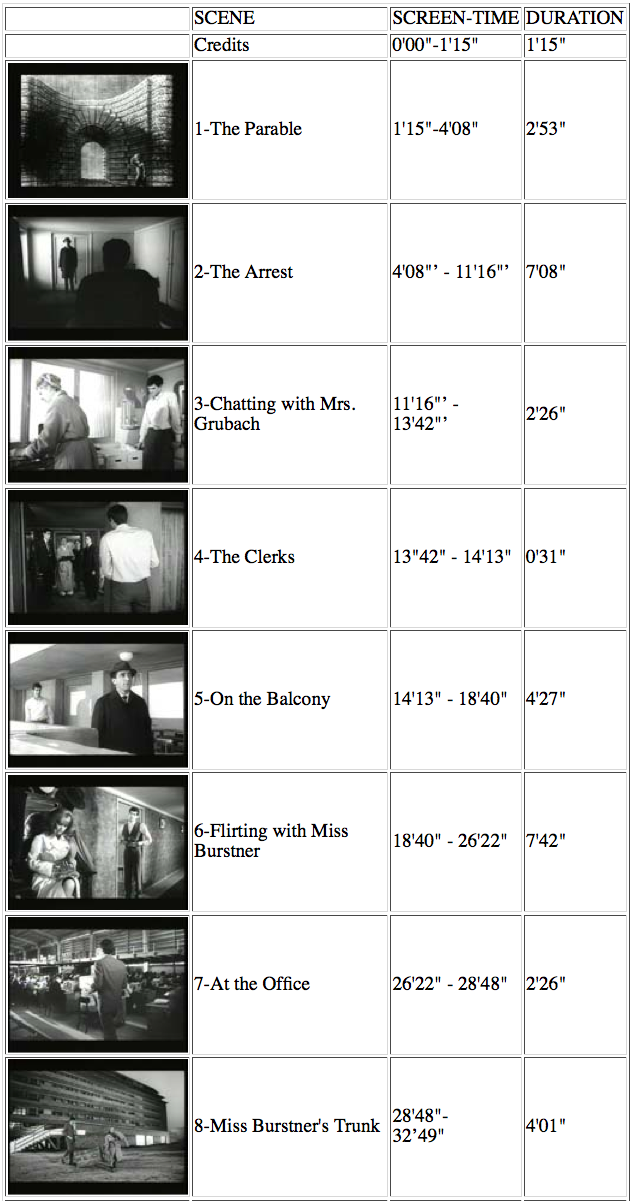
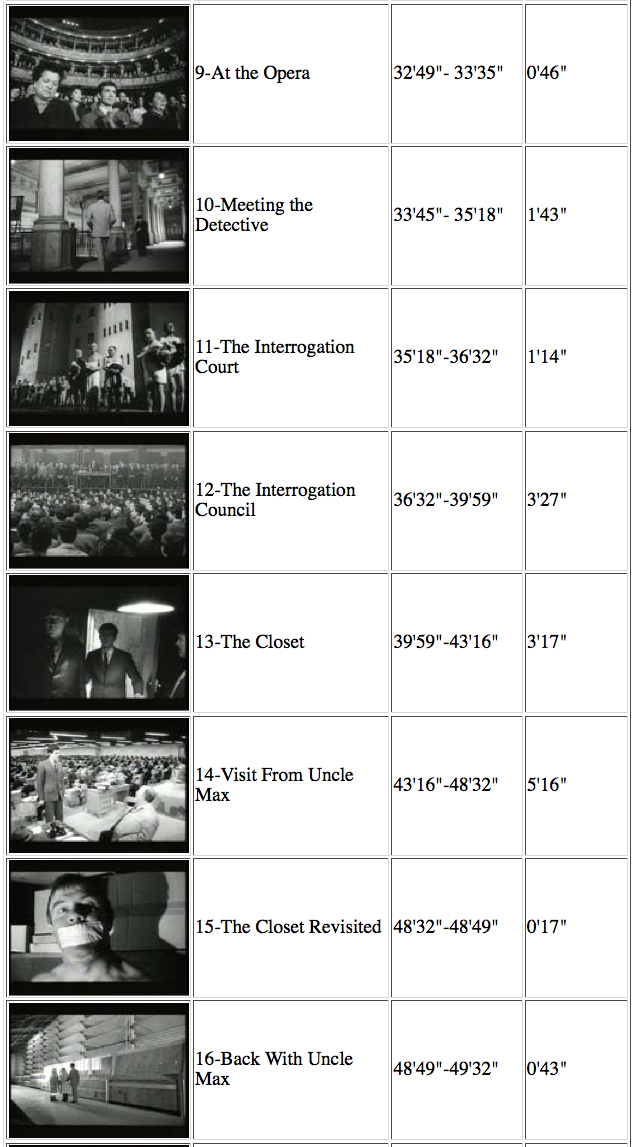
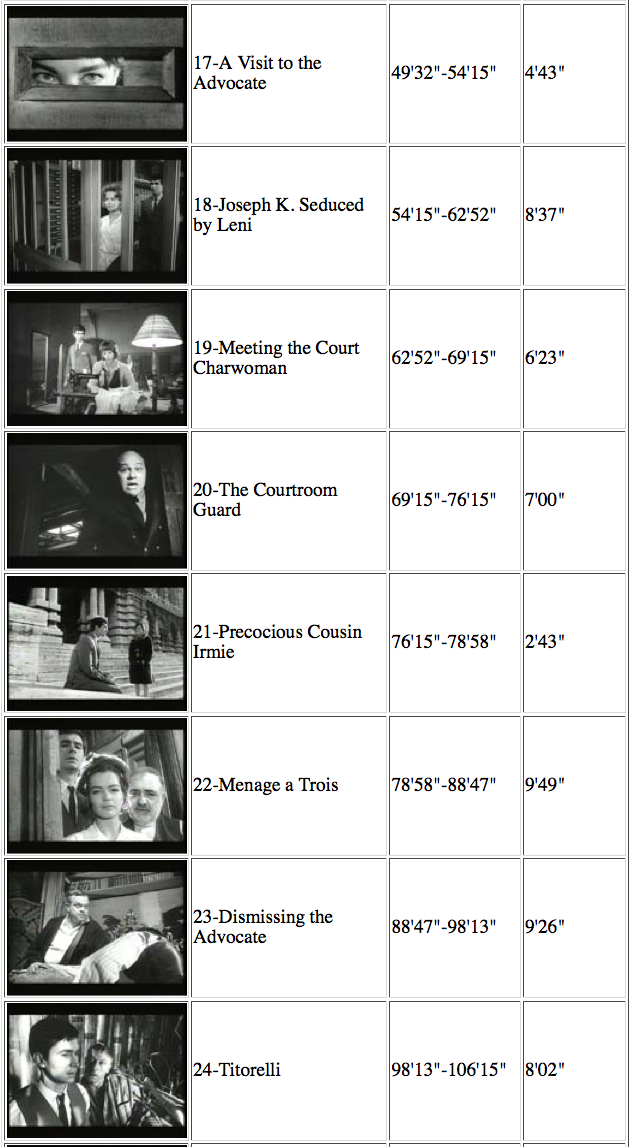
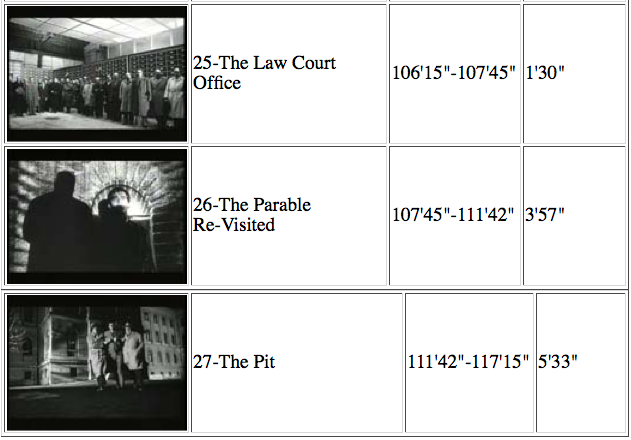
Read Part 1 Here.
BIBLIOGRAPHY
Bacher, Lutz. “The Mobile Mise-en-scène: A critical analysis of the theory and practice of long-take camera movement in the narrative film.” Master’s Thesis, Wayne State University, Detroit, 1976. New York: Arno Press, 1978.
Bergson, Henri. Matter and Memory. Translated by Nancy Margaret Paul and W. Scott Palmer. Lndon: MacMillan, 1911.
Bordwell, David. “Camera Movement and Cinematic Space.” Cine-Tracts. 1-2, Summer, 1977,19 – 25.
Burch, Noel. “Mizoguchi Kenji.” To the Distant Observer: Form and Meaning in the Japanese Cinema. Berkeley & Los Angeles: University of California Press, 1979, pp. 217 – 230.
Deleuze, Gilles. Cinema 1: The Movement-Image. Translated by Hugh Tomlinson and Barbara Habberjam London: The Athlone Press, 1986.
Deleuze, Gilles. Cinema 2: The Time-Image. Translated by Hugh Tomlinson and Robert Galeta Minneapolis: University of Minnesota Press, 1989.
Durgnat, Raymond. “The Restless Camera.” Films & Filming. 15/3, December 1968, pp. 14 -18.
Fry, Nicholas, trans. The Trial: A film by Orson Welles. Ed. Sandra Wake. London: Lorrimer Publishing, 1970.
Harpole, Charles Henry. “Gradients of Depth in the Cinema Image.” Dissertation, New York University, New York, 1976. New York: Arno Press, 1978.
Henderson, Brian. “Two Types of Film Theory (1971).” A Critique of Film Theory. New York: E. P. Dutton, 1980, pp. 16 – 31.
Henderson, Brian. “The Structure of Bazin’s Thought.” A Critique of Film Theory. New York: E. P. Dutton, 1980, pp. 32 – 47.
Henderson, Brian. “The Long Take.” A Critique of Film Theory. New York: E. P. Dutton, 1980, pp. 48 – 61.
Henderson, Brian. “Toward a Non-Bourgeois Camera Style.” A Critique of Film Theory. New York: E. P. Dutton, 1980, pp. 62 – 81.
Henderson, Brian Robert. “Classical Film Theory: Eisenstein, Bazin, Godard, and Metz.” Dissertation, University of California Santa Cruz, 1975. Ann Arbor, Michigan: Xerox University Microfilms, 1986.
Johnson, Vida, T. and Graham Petrie. The Films of Andrei Tarkovsky: A Visual Fugue. Bloomington & Indianapolis: Indiana University Press, 1994.
Kennedy, Barbara M. Deleuze and Cinema: The Aesthetics of Sensation. Edinburgh, Scotland: Edinburgh University Press, 2000.
Konigsberg, Ira. The Complete Film Dictionary (2nd ed). New York: Penguin Books, 1997.
Le Fanu, Mark. “Metaphysics of the Long Take: Some post-Bazinian reflections.” P.O.V.: A Danish Journal of Film Studies. No. 4, December 1997 “On camera movement and filmic space “
Mitry, Jean. “The Moving Camera.” In The Aesthetics and Psychology of the Cinema. Trans. Christopher King. Bloomington: Indiana University Press, 1997, pp. 183 – 190.
Read, Herbert. “Toward a Film Aesthetic.” Cinema Quarterly. Vol. I, No. 1, 1932, pp. 8 – 9.
Sontag, Susan. Against Interpretation. New York: Farrar, Straus and Giroux, 1966.
Sontag, Susan. “A Note on Novels and Films”. Against Interpretation and Other Essays. New York: The Noonday Press, 1966, p. 242 – 245.
Sontag, Susan. A Susan Sontag Reader. New York: Farrar, Straus and Giroux, 1982, pp. 95 – 104.
Schwab, Martin. “Escape from the Image: Deleuze’s Image-Ontolotgy.” In The Brain is the Screen: Deleuze and the Philosophy of Cinema. Ed. Gregory Flaxman. 1st ed. Minneapolis,Minnesota: University of Minnesota Press, 2000, pp. 109 – 139.
Notes
- This paper is very much a thinking through of ideas presented by Film Studies Lecturer Dr. Donato Totaro in his course “Moving Camera Aesthetics.” ↩
- Deleuze, Gilles. Cinema 1: The Movement-Image. London: The Athlone Press, 1986, pp. 21. ↩
- Konigsberg, Ira. The Complete Film Dictionary. 2nd ed. New York: Penguin Books, 1997, 342 ↩
- Deleuze, Gilles. Cinema 2: The Time-Image. Minneapolis: University of Minnesota Press, 1989, pp. 99. ↩

